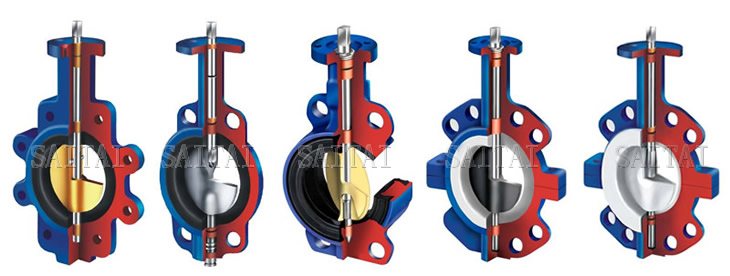Summary

A butterfly valve is a type of flow control device, typically used to regulate a fluid flowing through a section of pipe. The valve is similar in operation to a ball valve. A flat circular plate is positioned in the center of the pipe. The plate has a rod through it connected to an actuator on the outside of the valve. Rotating the actuator turns the plate either parallel or perpendicular to the flow. Unlike a ball valve, the plate is always present within the flow, therefore a pressure drop is always induced in the flow regardless of valve position.
A butterfly valve is from a family of valves called quarter-turn valves. The "butterfly"is a metal disc mounted on a rod. When the valve is closed, the disc is turned so that it completely blocks off the passageway. When the valve is fully open, the disc is rotated a quarter turn so that it allows an almost unrestricted passage of the process fluid. The valve may also be opened incrementally to regulate flow.
There are different kinds of butterfly valves, each adapted for different pressures and different usage. The resilient butterfly valve, which uses the flexibility of rubber, has the lowest pressure rating. The high performance butterfly valve, used in slightly higher-pressure systems, features a slight offset in the way the disc is positioned, which increases the valve's sealing ability and decreases its tendency to wear. The valve best suited for high-pressure systems is the tricentric butterfly valve, which makes use of a metal seat, and is therefore able to withstand a greater amount of pressure.
The butterfly valve has a body, a resilient seat, a butterfly disk, a stem, packing, a notched positioning plate, and an actuator. The resilient seat is under compression when it is mounted in the valve body, thus making a seal around the periphery of the disk and both upper and lower points where the stem passes through the seat. Packing is provided to form a positive seal around the stem for added protection in case the seal formed by the seat should become damaged. To close or open a butterfly valve, the actuator is turned only one quarter turn to rotate the disk from 0° to 90°. Actuators used on butterfly valves vary based on the application and size of the valve. A simple handle oriented in the same direction of the metal disc (to indicate valve position) is common. Some larger butterfly valves may have a handwheel that operates through a gearing arrangement to operate the valve. This method is used especially where space limitation prevents use of a long handle. Acuators may also be air driven or electrically operated when used as part of an automated control system.
Butterfly valves are relatively easy to maintain. The resilient seat is held in place by mechanical means, and neither bonding nor cementing is necessary, Because the seat is replaceable, the valve seat does not require lapping, grinding, or machine work.
Butterfly valves are valves with a circular body and a rotary motion disk closure member which is pivotally supported by its stem. A Butterfly valve can come in various styles including eccentric and high-performance valves. These are normally a type of valve that uses a flat plate to control the flow of water. As well as this, Butterfly valves are used on fire apparatus and typically are used on larger lines, such as front and rear suctions and tank to pump lines. A Butterfly valve is also a type of flow control device, used to make a fluid start or stop flowing through a section of pipe. The valve is similar in operation to a ball valve. Rotating the handle turns the plate either parallel or perpendicular to the flow of water, shutting off the flow. It is a very well known and well used design.
Whether your application requires Pressure, Level, Pump, or Flow Control, Remy is your best choice for Selection, Sales, and Service.
Products List
Supplier: Saitai Valve, China
Manufacturer: Shop in Shanghai Qingpu Industrial Park
鏈珯鏇存柊浜庡綋鍓嶆椂闂?024-11-28 2:52:03